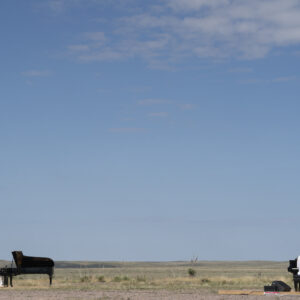
What Does a Million Years Mean to You? Five Books That Explore Deep Time
Tim Weed Recommends Robert Hazen, Marcia Bjornerud, Thomas Halliday and More
Halfway through the third decade of the twentieth century, everything on planet Earth is not okay. Wildfires and floods, heat waves and melting glaciers, an accelerating battery of deadly tornadoes and hurricanes, habitat loss, oceans choked with plastic, forever chemicals in our air and water and food, and the looming prospect of a sixth mass extinction: our multipronged environmental crisis weighs heavily on minds of most humans living in the world today.
If you’re paying attention—and not drunk on the denialist Kool-Aid—it may be hard to avoid feelings of despair. But despair is a paralyzing emotion. If we are to secure any kind of tolerable future of our species, we really ought to avoid it.
For me personally, avoiding despair means spending as much time as possible outdoors, in the forest and mountains and on or in the ocean. It means surrounding myself with friends and loved ones, finding communities, engaging in various forms of suitable resistance, and occupying myself in absorbing practices of work and play.
Recently, it has also meant acquiring a new perspective on time itself. This came as a biproduct of the research I did for my new novel, The Afterlife Project. Among the novel’s areas of interest are geological time, mass extinction, and long-term ecological recovery; I read a lot on these and related topics, and here are five books that stood out.
*
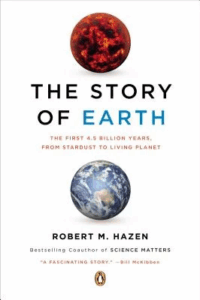
Robert Hazen, The Story of Earth: The First 4.5 Billion Years, from Stardust to Living Planet
This clearly written and highly readable book lays out a perspective on the world that is exhilaratingly defamiliarized. I couldn’t put it down, and will never see the planet or the rocks we’re all standing on in the same light. Around the time I was reading it, I delivered a talk with another novelist called “Writing the Climate Crisis,” at which one of the attendees asked something to the effect of how do you keep from succumbing to hopelessness given what’s happening to the world.
The answer that came out of my mouth, surprising even myself, was “geological time.” That is, putting the current environmental crisis in the long context of Earth history can do wonders for one’s mood. Reading a book like this is one of the best ways I know to gain an appreciation for the scope, majesty, and wonder of geological time.
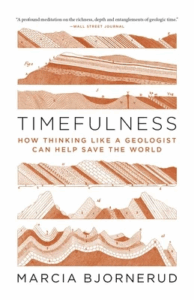
Marcia Bjornerud, Timefulness: How Thinking Like a Geologist Can Help Save the World
Most humans alive today are time-illiterate; our sense of planetary history is approximately analogous to the medieval European’s sense of the true scale of planetary geography. If you look at world maps from the middle ages, you might begin to appreciate how out of proportion our sense of geological time is. What does a million years mean to you? How about 4.5 billion years, which is the approximate duration (so far), of our planet’s geological history?
Bjornerud’s thought-provoking book has inspired me to try to address that shortcoming in my own worldview. Although I still don’t have even a tentative grasp of what 4.5 billion years might actually feel like, I do at least have an intellectual appreciation for the sheer difficulty of imagining something on that scale. Metaphors are helpful, in almost the same way looking at a zoomed-out map can help you visualize where you’re going or where you’ve been on a cross-continental road trip.
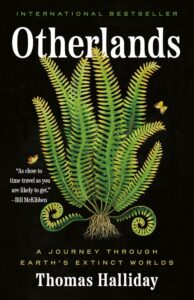
Thomas Halliday, Otherlands: A Journey Through Earth’s Extinct Worlds
Halliday gives us an easy-to-imagine metaphor for the history of life on Earth as a hike across Australia from Adelaide in the south to Darwin in the north. The hike is approximately 3500 kilometers; each kilometer is the equivalent of a million years back in time, each millimeter is the equivalent of a year. “Take but one step,” Halliday writes, “and all colonial influence is gone.” Seventeen meters on and you’re back in the Pleistocene, with mammoths and giant pythons and cow-sized wombats. Walk a city block and you’ve outdistanced the entire history of the human species. Walk a marathon and you’re in the Eocene, when lush forests covered the land connecting Australia, Antarctica, and South America.
But the hike is just getting started. After two weeks of walking, 550 kilometers from the start point, you hit the Cambrian explosion, a period of rapid evolution when many of the major animal groups begin to appear in the fossil record.
And the remaining 2950 kilometers of this ambitious trans-Australian hike? “Ahead, in the endless outback of early Earth history,” Halliday writes, “are only microbes.”
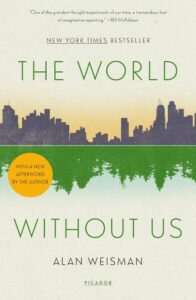
Alan Weisman, The World Without Us
The premise of this fascinating book—what would happen to the world if humanity suddenly disappeared?—was a major point of inspiration for my novel, The Afterlife Project.
A few relevant highlights: Wood-frame buildings with slate or shingle roofs would last maybe a few decades; the better-built houses no more than fifty or a hundred years. Megafauna predators like wolves and big cats would spread pretty quickly back across the newly uninhabited planet. Exposed plastic bags would degrade in fifty years, aluminum in a few centuries more. Glass bottles would be gone in half a millennium, Styrofoam after perhaps a millennium or two. Ceramics and stonework would last longer, but the encroaching vegetation and deposited silt and organic material would soon cover them, and within five centuries most towns and cities would be swallowed up by forests, dunes, and flooding river deltas.
After several thousand years a sentient observer would be hard-pressed to discover any evidence at all of humanity’s brief tenure on the land masses of Earth. Bill McKibben called this book “one of the grandest thought experiments of our time.”
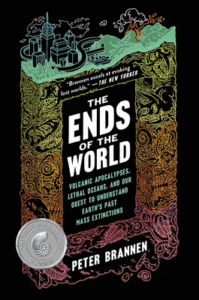
Peter Brannen, The Ends of the World: Volcanic Apocalypses, Lethal Oceans, and Our Quest to Understand Earth’s Past Mass Extinctions
In this lively and extremely well-researched account Brannen focuses on each of the five mass extinctions life on this planet has undergone in its 4.5 billion year history. The good news? The conditions that caused every one of those previous extinctions look to be more severe than what we’re facing now. The bad news? Well, we are indeed at the beginning of a sixth mass extinction—and we’re definitely the ones causing it.
Because while most of the Earth’s past mass extinctions were caused by total accumulations of greenhouse gases orders of magnitude higher than what we’re looking at now, even under the IPCC’s worst-case scenarios, our climate is poised to change far too rapidly, over just an eye-blink of geological history, a disaster made worse by the drastic habitat depletion that has followed the explosion of the human population. Unless we act in very short order to secure the future, humanity and many of the wondrous array of other species with whom we currently share the planet may not have time to adapt.
*
The most important thing I take away from Brannen’s book—and all the books on this list—is that while many currently existing species (including H. Sapiens) are in grave and imminent danger, the underlying organism—the great self-sustaining planetary being that scientist Dr. James Overlock called “GAIA”—will very likely continue to flourish. I find this kind of big-picture perspective on time—deep time, geological time, that 4.5 billion year record upon which we humans are now making our unfortunate and indelible mark—both exhilarating and, on some level, profoundly reassuring.
The deep-time perspective of all these books has given me a better vantage point on the current moment, not only as it relates to the trajectory of the human species but also to the long and varied story of life on Earth. While I do fear that humanity’s circumstances are likely to get worse before they get better, the zoomed-out perspective of deep time has given me surprising new grounds for optimism.
To paraphrase Marcia Bjornerud in Timefulness, it’s not the end of nature we’re looking at, but the end of the illusion that we’re not part of nature. The illusion that we weren’t birthed and embedded in the ebb and flow, the stew and ferment of life on this immense and complex and very old planet—or that it won’t move along just as as it always has when we’re gone.
For me this is a despair-conquering perspective, because it points the way to a future in which humans finally come to accept our destiny as stewards of planetary nature. Let us pursue lives of authentic happiness and joy while being attentive to the great web of life that surrounds and sustains us. Not only because it’s the right thing to do, but because it’s the best way to ensure a future for many new generations of humans still to come.
__________________________________
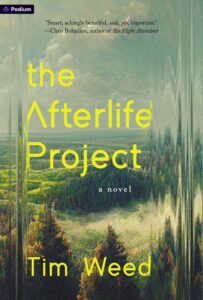
The Afterlife Project by Tim Weed is available from Podium Publishing.
Tim Weed
Tim Weed is the author of The Afterlife Project (Podium Publishing, June 3, 2025) and two previous books of fiction. A former international travel guide, he serves on the core faculty of the Newport MFA in Creative Writing and is the co-founder of the Cuba Writers Program. Tim is the winner of several Writer’s Digest Popular Fiction Awards, and his work has appeared in Literary Hub, The Millions, The Writer’s Chronicle, Talking Points Memo, and elsewhere. He divides his time between rural Vermont and the island of Nantucket.


















